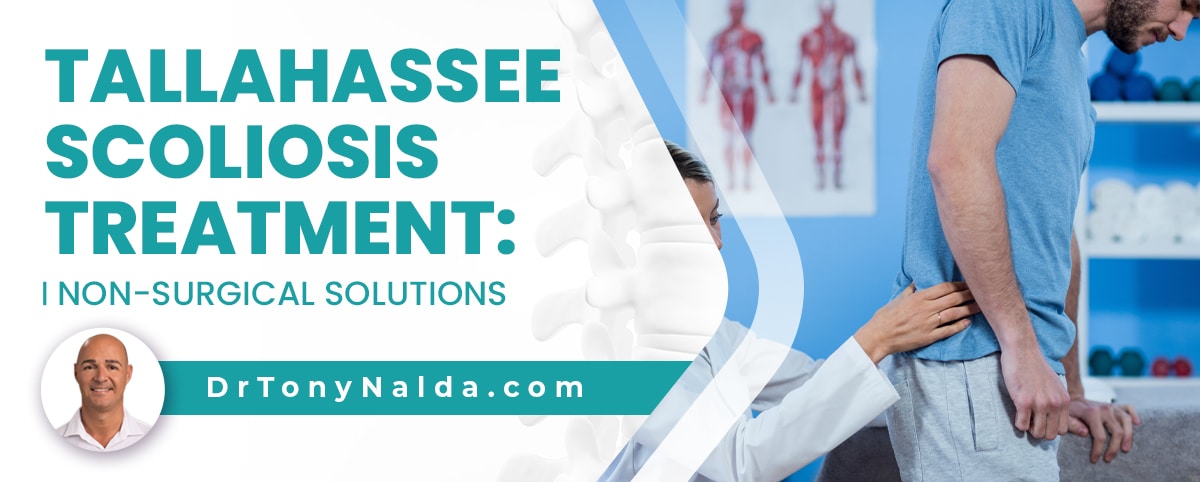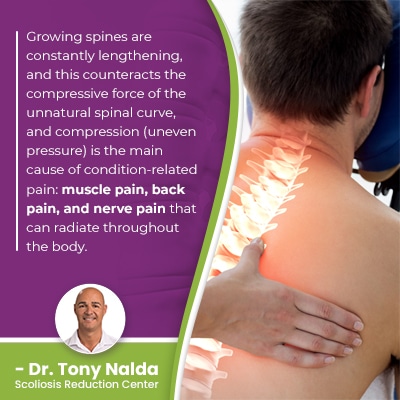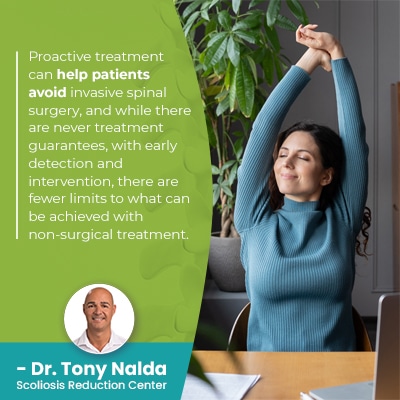Tallahassee Scoliosis Treatment: Non-Surgical Solutions

Scoliosis treatment is important because as a progressive condition, it's virtually guaranteed to get worse over time. Scoliosis treatment can involve a surgical response or a non-surgical response, and the choice of committing to one over another can have far-reaching effects.
To drive from Tallahassee fl to Orlando fl takes approximately 4 hours, but traversing the 256 miles puts scoliosis patients within reach of the industry-leading Scoliosis Reduction Center® where patients benefit from a proactive non-surgical treatment approach.
A scoliosis diagnosis means an unnatural lateral curve in the spine has developed, and as the curve also rotates, the condition is 3-dimensional.
Table of Contents
Scoliosis Prevalence
Scoliosis is a highly-prevalent spinal condition that the Scoliosis Research Society estimates affects close to seven million Americans.
It is also the leading spinal condition among school-aged children, and as a progressive condition triggered by growth, childhood scoliosis should always be taken seriously.
Not only does scoliosis range widely in severity, there are also different types of the condition, and the most prevalent is adolescent idiopathic scoliosis diagnosed between the ages of 10 and reaching skeletal maturity.
While the condition is more commonly diagnosed in children, the actual rate of scoliosis increases among the aging population, and this is due to natural age-related spinal degeneration affecting older adults.
Once the spine starts to experience degenerative changes, it can become increasingly unbalanced and unstable, making it vulnerable to conditions like scoliosis that cause a loss of healthy spinal curves.
If scoliosis is left untreated and becomes severe, severe health consequences can develop.
Scoliosis Severity
Scoliosis ranges widely in severity from mild scoliosis to moderate scoliosis and severe to very severe scoliosis.
Scoliosis severity is determined during X-ray with a measurement known as Cobb angle, and this involves drawing lines from the tops and bottoms of the curve's most-tilted vertebrae, and the resulting angle is expressed in degrees.
A patient's Cobb angle is a key piece of information treatment plans are shaped around, and the higher a Cobb angle, the more unnaturally tilted the curve's vertebrae are, the further out of alignment the spine is, and the more noticeable the condition's effects are likely to be.
When it comes to scoliosis effects, children and adults experience the condition differently.
Childhood vs Adult Scoliosis
 Childhood scoliosis is more common, but adults are affected too, and the main difference in the child and adult experience of scoliosis involves pain.
Childhood scoliosis is more common, but adults are affected too, and the main difference in the child and adult experience of scoliosis involves pain.
While no two cases of scoliosis are the same, with most patients, scoliosis begins to become painful once skeletal maturity has been reached.
Growing spines are constantly lengthening, and this counteracts the compressive force of the unnatural spinal curve, and compression (uneven pressure) is the main cause of condition-related pain: muscle pain, back pain, and nerve pain that can radiate throughout the body.
The lack of pain in childhood scoliosis is a challenge to early detection as the condition's effects aren't always overt, and particularly when mild, the main signs of scoliosis in children can be difficult to detect.
Scoliosis and Posture
The main symptoms of childhood scoliosis involve postural changes caused by the condition's uneven forces disrupting the body's overall symmetry.
In many cases, the earliest signs of scoliosis in children are uneven shoulders and hips, and additional changes can include:
- Uneven shoulder blades
- The development of a rib cage arch
- Uneven hips
- Arms and legs hanging differently
As these types of changes develop, clothing can start to fit unevenly, and changes to balance, coordination, and gait are also common.
And remember, as a progressive condition, the nature of scoliosis is to get worse over time, so for adults and children alike, where a scoliosis is at the time of diagnosis doesn't indicate that's where it will stay, particularly if left untreated, or not treated proactively.
Condition effects get worse alongside progression, hence the benefit of a proactive treatment approach that works towards preventing progression, increasing effects, and the need for invasive surgical treatment in the future.
Proactive Scoliosis Treatment
Dr. Tony Nalda's Scoliosis Reduction Center® is worth the 4-hour drive for Tallahassee fl residents because once a patient of the Center, they have access to multiple different types of treatment under one roof.
A non-surgical scoliosis treatment approach is proactive and is started as close to the time of diagnosis as possible; this is when conditions will be at their mildest and most responsive.
It's simpler to correct a small curve than a large curve, and in most cases of progressive conditions, it's more effective to proactively work towards preventing progression and its effects than attempting to reverse bodily changes once they're established; the body's compensations can be impressive.
Proactive treatment can help patients avoid invasive spinal surgery, and while there are never treatment guarantees, with early detection and intervention, there are fewer limits to what can be achieved with non-surgical treatment.
Conservative Scoliosis Treatment Disciplines
 The Center's approach is unique in its innovation and integration; Dr. Tony customizes treatment plans around key patient/condition variables and because he is trained and certified in multiple different treatment modalities, treatment disciplines can be apportioned accordingly based on how the spine is responding.
The Center's approach is unique in its innovation and integration; Dr. Tony customizes treatment plans around key patient/condition variables and because he is trained and certified in multiple different treatment modalities, treatment disciplines can be apportioned accordingly based on how the spine is responding.
Chiropractic care is applied to impact the condition's underlying structural nature, and this can involve a series of techniques and manual adjustments that work towards realigning the spine.
Physical therapy and scoliosis exercises are also applied to work towards improving the spine's surrounding muscle strength and balance, and as this happens, the spine is optimally supported and stabilized.
A muscular imbalance is also associated with scoliosis as the spine's unnatural bend and twist pulls its surrounding muscles in different directions.
Corrective bracing can be particularly effective on growing spines, so is a common form of treatment in childhood scoliosis and can help by pushing the spine into a corrective position.
Rehabilitation is about holding treatment results, and this can mean continued chiropractic care and specific exercises for further healing and stabilizing the spine that can be performed from home.
Scoliosis Surgery
When it comes to scoliosis surgery, we're mainly talking about spinal fusion, and this involves fusing the spine's most-tilted vertebrae into one solid bone and attaching metal rods to the spine to hold it in place; this can straighten a bent spine, but the way it does so is contrary to the spine's movement-based design.
Spinal fusion can also cost the spine in other ways.
Once a spine is fused, it's fused for life, and this means if hardware fails or malfunctions, the only recourse is more surgery, and the risks of spinal surgery increase with each subsequent procedure and increasing age.
A spine that's fused is going to be weaker and more vulnerable to injury, and this can involve activity restrictions that can impact quality of life.
An increase in back pain at the fusion site is also common, and the most common effect is a spine that's less flexible, and a reduced range of motion in the spine is another effect that can shape a patient's quality of life.
So while spinal fusion still has a place in scoliosis treatment, particularly in atypical cases or severe cases, the truth is that many scoliosis patients don't require surgical treatment, and as the risks are real, the procedure should be considered carefully.
Conclusion
So for Tallahassee FL residents, while many cross the country to access what Dr. Tony's Center has to offer, a 4-hour drive can mean accessing multiple powerful non-surgical treatment disciplines under one roof.
What's unique about this approach is that it's proactive, modern, and integrative, and while surgical treatment has different potential results to offer, conservative non-surgical treatment works towards preserving as much of the spine's natural strength and function as possible.
When it comes to fusing the spine, there are both risks associated with the procedure itself, and the long-term effects of living with a fused spine.
While there are never treatment guarantees, the reason proactive treatment can be so beneficial is because as scoliosis progresses, the condition is becoming more complex to treat, and this is, in part, due to increasing spinal rigidity making it less responsive to treatment.
If the spine is too rigid, I can't perform specific spinal adjustments, and patients are likely unable to perform a number of therapeutic exercises as part of treatment.
When it comes to treating typical cases of scoliosis, we're talking about idiopathic scoliosis, and atypical cases are associated with known cases such as neuromuscular scoliosis, congenital scoliosis, and degenerative scoliosis.
Degenerative disorders that affect the spine can cause it to become increasingly unbalanced and unstable, and while adult scoliosis gradually progresses, when age-related spinal degeneration comes into play, a simple misalignment can get worse rapidly.
So the best time to start scoliosis treatment is always now; don't hesitate to reach out for guidance, support, and effective non-surgical scoliosis treatment options.
Dr. Tony Nalda
DOCTOR OF CHIROPRACTIC
After receiving an undergraduate degree in psychology and his Doctorate of Chiropractic from Life University, Dr. Nalda settled in Celebration, Florida and proceeded to build one of Central Florida’s most successful chiropractic clinics.
His experience with patients suffering from scoliosis, and the confusion and frustration they faced, led him to seek a specialty in scoliosis care. In 2006 he completed his Intensive Care Certification from CLEAR Institute, a leading scoliosis educational and certification center.
About Dr. Tony Nalda
 Ready to explore scoliosis treatment? Contact Us Now
Ready to explore scoliosis treatment? Contact Us Now





